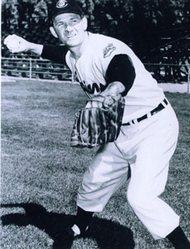

|
|
George Strickland
Date and Place of Birth:
January 10, 1926
Baseball Experience:
Major
League
Position:
Infield
Rank:
Specialist Mailman
Military Unit:
US Navy
Area Served: Pacific Theater of Operations
 George
B Strickland was born on
January 10, 1926 in
George
B Strickland was born on
January 10, 1926 in
Strickland signed with his hometown New Orleans
Pelicans in September 1943 and made his pro debut at third base on
September 5, collecting two hits. But his baseball career had to be
put on hold because the 18-year-old was drafted by the military in
March 1944.
Strickland served with the Navy and following
boot camp in
Strickland remembers
Strickland was a Specialist Mailman and his unit
would service PBY Catalina and PBM Mariner flying boats that landed
at
George remembers playing softball one day when a
fellow came over with a couple of boxes of baseballs and asked him
if he would throw some batting practice. George soon realized that
he was throwing BP to Barney McCosky of the Detroit Tigers
(Strickland and McCosky would later be teammates at
Strickland was discharged from the Navy in May
1946. He returned to the Pelicans (one of eight local players on
that team) and batted .242 with two home runs and 23 RBIs. He was
drafted by the Boston Red Sox at the end of the season and went to
spring training with the major league club in 1947. He played for
Strickland had a strong season with
Strickland was a scout with the Indians in 1961,
and joined the Minnesota Twins as a coach in 1962. Between 1963 and
1969 he was back with the Indians as a coach and managed the club in
1964 and 1966.
In 1970, Strickland’s good friend and former
Reflecting on his four
decades in professional baseball, Strickland says, “Lou Gehrig said
he considered himself
the luckiest man on the face of this earth. Well, I consider myself
the most fortunate.”
George Strickland lives
happily in retirement in
Thanks to George Strickland for sharing this
information with me.
Created November 22, 2007.
Copyright © 2008 Gary Bedingfield (Baseball in Wartime). All Rights Reserved.